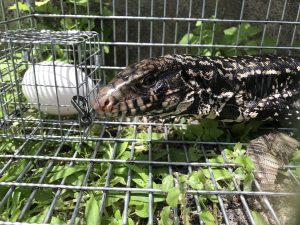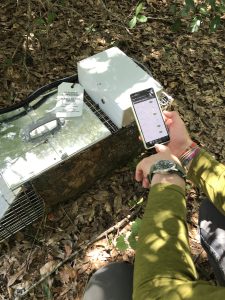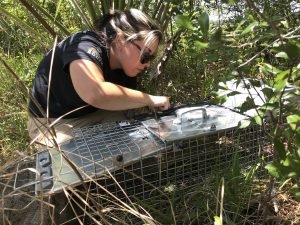-

This Argentine black and white tegu was captured in St. Lucie County, where the population has grown. Argentine black and white tegus are large non-native invasive lizards posing a threat to the biodiversity and natural balance of Florida’s ecosystems.
- Tegus have a diverse diet including fruits, vegetables, insects, small animals and protected wildlife. They can also hibernate underground allowing them to survive cold temperatures.
- A team of scientists at the University of Florida Institute of Food and Agricultural Sciences (UF/IFAS) are collaborating on a project in which researchers are testing traps equipped with artificial intelligence software on a growing population established in Ft. Pierce.
Is artificial intelligence (AI) a viable tool in the fight against invasive species?
UF/IFAS scientists are exploring that question on a small scale in a project using traps equipped with AI technology. For this study, the traps are targeting Argentine black and white tegus in Fort Pierce.
Scientists hope these AI ‘smart traps’ will help suppress and remove an established population of these lizards that have quickly invaded this Treasure Coast city. St. Lucie county has become a hot spot for tegus over the last seven years.

They hope these traps can reduce resources needed to remove tegus because they’re automated and can be operated remotely.
“If we can implement innovative solutions to remove invasive species that are effective and reduce costs, that is a win-win,” said Melissa Miller, project lead and research assistant scientist specializing in invasion ecology at the UF/IFAS Fort Lauderdale Research and Education Center
The ability to operate traps via a web interface, eliminating daily visits to checking traps, saves time and resources that can be used to combat other invasive species in Florida, said Miller, who is also affiliated with UF/IFAS Croc Docs and the UF/IFAS Invasive Science Research Institute.
The Argentine black and white tegus, native to South America, are found in abundance in several counties in Central and South Florida and have also been introduced as far north as Georgia. They can grow up to four feet long and weigh over 10 pounds. They can lay an average of 35 eggs in a clutch during breeding season.
These ground-dwelling lizards, known for being resourceful, can inhabit natural and agricultural lands and dig burrows in which they hibernate over winter. They forage on insects, plants and small vertebrates. They are known to raid eggs from nests of native wildlife, including those of the American alligator and have been documented to prey on threatened species such as juvenile gopher tortoises.
For this AI project, the UF/IFAS team worked with Wild Vision Systems, which designed the traps and the AI technology. The software is designed to recognize tegus by identifying their iconic patterned skin from thousands of photos. The software leverages a mobile web application for users, providing remote control and monitoring of the trap, real-time notifications of captures and other features. Once the trap recognizes the tegu, the trap doors close automatically capturing the lizard and notifying the trap operator with a mobile alert.

The tegu project is the first field test of the AI smart traps. The team deployed 10 traps in St. Lucie County from May through October 2023. In that time, the tegus that entered the traps were successfully captured, resulting in removal of 15 tegus from the study site. This gave scientists a look at its potential for capturing invasive lizards and other species.
The team hopes to start a second phase of the tegu project, incorporating modifications to further enhance the software’s efficacy, beginning this summer.
“We are hoping to secure funding that will allow us to continue work with the Wild Vision Systems team in exploring additional software designed to capture other invasive reptiles including green iguanas, spiny tailed iguanas and Nile monitors,” said Miller.
Researchers and natural resource managers have developed cooperative programs over the last decade using a variety of control tools to detect, monitor, and remove tegus where they have spread and established populations. This is all to reduce tegu abundance and help contain their populations in Florida.
“The use of AI in invasive species research and management seems promising and a natural next step in exploring novel methods to outsmart invasive species,” said Miller.
Para accesar a esta comunicación en español, por favor utilice este enlace.
###
By Lourdes Rodriguez, rodriguezl@ufl.edu
ABOUT UF/IFAS
The mission of the University of Florida Institute of Food and Agricultural Sciences (UF/IFAS) is to develop knowledge relevant to agricultural, human and natural resources and to make that knowledge available to sustain and enhance the quality of human life. With more than a dozen research facilities, 67 county Extension offices, and award-winning students and faculty in the UF College of Agricultural and Life Sciences, UF/IFAS brings science-based solutions to the state’s agricultural and natural resources industries, and all Florida residents.
 4
4
